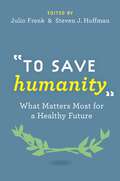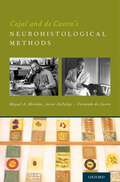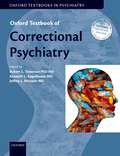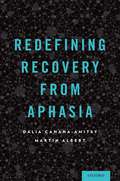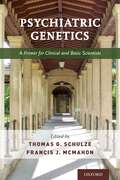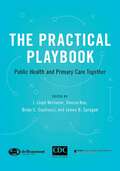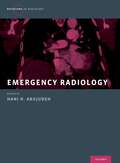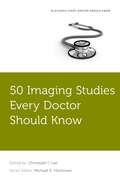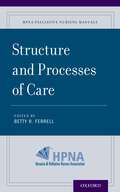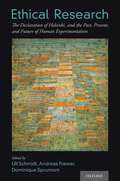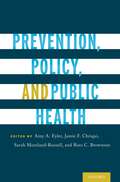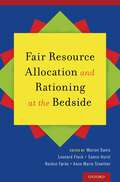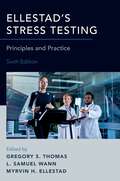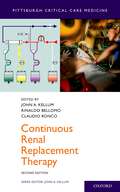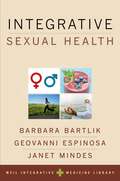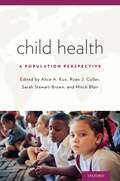- Table View
- List View
To Save Humanity: What Matters Most for a Healthy Future
by Julio Frenk Steven Hoffman"The UN was not created to take mankind to heaven, but to save humanity from hell." --Dag Hammarskjöld, United Nations Secretary-General 1953-1961 The turn of the 21st century was an objective low point in the history of human health: AIDS was scourging Africa, millions of women died each year in child birth, and billions suffered under malnourishment and poverty. In response, the United Nations launched its Millennium Development Goals (MDGs), an ambitious charter that since 2000 has measurably reduced the worldwide burdens of poverty, hunger, and disease. With the MDGs set to expire in 2015, continued progress on these fronts is anything but certain. In addition to the persisting threats of the 20th century, globalization has sped the development of new threats--pandemics, climate change, chronic disease--that now threaten rich and poor countries equally. "To Save Humanity" is a collection of short, honest essays on what single issue matters most for the future of global health. Authored by the world's leading voices from science, politics, and social advocacy, this collection is both a primer on the major issues of our time and a potential blueprint for post-2015 health and development. This unparalleled collection will provide illuminating and thought-provoking reading for anyone invested in our collective future and well-being.
To Save Humanity: What Matters Most for a Healthy Future
by Steven Hoffman Julio Frenk"The UN was not created to take mankind to heaven, but to save humanity from hell." --Dag Hammarskjöld, United Nations Secretary-General 1953-1961 The turn of the 21st century was an objective low point in the history of human health: AIDS was scourging Africa, millions of women died each year in child birth, and billions suffered under malnourishment and poverty. In response, the United Nations launched its Millennium Development Goals (MDGs), an ambitious charter that since 2000 has measurably reduced the worldwide burdens of poverty, hunger, and disease. With the MDGs set to expire in 2015, continued progress on these fronts is anything but certain. In addition to the persisting threats of the 20th century, globalization has sped the development of new threats--pandemics, climate change, chronic disease--that now threaten rich and poor countries equally. "To Save Humanity" is a collection of short, honest essays on what single issue matters most for the future of global health. Authored by the world's leading voices from science, politics, and social advocacy, this collection is both a primer on the major issues of our time and a potential blueprint for post-2015 health and development. This unparalleled collection will provide illuminating and thought-provoking reading for anyone invested in our collective future and well-being.
Cajal and de Castro's Neurohistological Methods
by Miguel A Merchán Javier De Felipe Fernando de CastroCajal and De Castro's Neurohistological Methods provides the first English translation of Fernando de Castro's 1933 publication "Elementos de Técnica Micrográfica del Sistema Nervioso." A student of the famed founder of modern neuroscience, with Santiago Ramon y Cajal also serving as the Editor of the original text, Fernando de Castro recorded all the various protocols that had been used in his laboratory by his students in order to provide a manual of histological procedures specifically designed for the fine structure of the nervous system. This renowned text is virtually unknown in its original form outside the Spanish-speaking world. In a text that reads like a mix between a recipe book and an alchemical manuscript, authors Miguel Merchan, Javier DeFelipe, and Fernando de Castro (descendant of the 1933 publication's author) put the new translation into historical context. This book is also beautifully illustrated with plates of histological techniques, provides a quick guide to new vocabulary, and the author's notes on the translated text. This pivotal work of classic neurohistological techniques is a wonderful addition to the Cajal library.
Cajal and de Castro's Neurohistological Methods
by Miguel A Merchán Javier De Felipe Fernando de CastroCajal and De Castro's Neurohistological Methods provides the first English translation of Fernando de Castro's 1933 publication "Elementos de Técnica Micrográfica del Sistema Nervioso." A student of the famed founder of modern neuroscience, with Santiago Ramon y Cajal also serving as the Editor of the original text, Fernando de Castro recorded all the various protocols that had been used in his laboratory by his students in order to provide a manual of histological procedures specifically designed for the fine structure of the nervous system. This renowned text is virtually unknown in its original form outside the Spanish-speaking world. In a text that reads like a mix between a recipe book and an alchemical manuscript, authors Miguel Merchan, Javier DeFelipe, and Fernando de Castro (descendant of the 1933 publication's author) put the new translation into historical context. This book is also beautifully illustrated with plates of histological techniques, provides a quick guide to new vocabulary, and the author's notes on the translated text. This pivotal work of classic neurohistological techniques is a wonderful addition to the Cajal library.
Oxford Textbook of Correctional Psychiatry (Oxford Textbooks in Psychiatry)
by Robert L. Trestman, Kenneth L. Appelbaum and Jeffrey L. MetznerCorrectional psychiatry has received increasing recognition as an area of practice with unique skills and knowledge. The Oxford Textbook of Correctional Psychiatry brings together American and international experts to provide a comprehensive overview of the field. Students and psychiatric residents will find basic information that prepares them for clinical rotations, and psychiatrists working in jails and prisons will find a detailed review of the complex issues that arise in these settings. The Oxford Textbook of Correctional Psychiatry contains 71 chapters divided into 14 sections. The first three sections address history, structure, and processes including chapters on case law, human rights, ethics, organization and funding of systems, and stages of patient management that cover initial assessments through re-entry. The next three sections review in turn a broad array of management issues, emergencies, and psychopharmacology topics. Among other topics, these sections include chapters on sleep, detoxification, reassessment of community diagnoses and treatments, diversion programs, levels of care, malingering, substance use within facilities, and formulary management. Section seven has chapters on common psychiatric disorders, relevant medical disorders, and pain management. Sections eight through ten focus on psychotherapeutic options, suicide risk management, and addictions treatment. Chapters on aggression, self-injury, and other behavioral challenges appear in Section eleven. Section twelve reviews unique assessment and treatment needs of many distinct population groups. Special topics such as forensics, psychological testing, sexual assaults, quality improvement, training, and research, appear in Section thirteen, followed by a section devoted to current resources in correctional healthcare. The range of topics covered and the number of prominent contributors set this book apart from other available resources. Readers at all stages of their careers will gain the depth of understanding and practical information they need to approach all of the common clinical, organizational, and ethical challenges they face.
Redefining Recovery from Aphasia
by Dalia Cahana-Amitay Martin AlbertThis book focuses on two fundamental aspects of brain-language relations: one concerns the neural organization of language in the healthy brain; the other challenges current approaches to treatment of aphasia and offers a new theory for recovery from aphasia. The essence of the book lies in the phrase neural multifunctionality: the constant and dynamic incorporation of non-linguistic functions into language models of the intact brain. The book makes the claim that language is a construction, created as we use it, and cannot be understood as being supported by neurally based linguistic networks only. Rather, language emerges from the constant and dynamic interaction among neural networks subserving cognitive, affective, and praxic functions with neural networks subserving lexical retrieval (naming), sentence processing (comprehension), and discourse (communication, conversation). In persons with stroke-induced aphasia, neural networks for executive system function, attention, memory, motor system function, visual system function, and emotion interact with neural networks for language to produce the aphasia profile and to influence recovery from aphasia. Consequently, neural multifunctionality in aphasia explains individual differences in the lesion-deficit model and continued recovery over time, redefining the concept of recovery from aphasia and offering new opportunities for treatment.
Psychiatric Genetics: A Primer for Clinical and Basic Scientists
Psychiatrists and other mental health professionals are increasingly confronted with questions about the genetics of psychiatric illness, and the clinical applications of new genetic findings. Psychiatric Genetics: A Primer for Clinical and Basic Scientists addresses these questions through a straightforward introduction to the essentials of psychiatric genetics, complementing more comprehensive textbooks that may seem overwhelming for those new to the field. Written and edited by leaders in the field and the International Society of Psychiatric Genetics (ISPG), the book covers basic epidemiology, recruitment for human studies, phenotyping strategies, formal genetic and molecular genetic studies, statistical genetics, bioinformatics and genomics, pharmacogenetics, the most relevant animal models, and biobanking. Each chapter begins with a list of "take home" points that summarizes content, followed by a brief overview of current knowledge and suggestions for further reading. This Primer is ideal for medical students, psychiatric residents, psychiatrists, and basic neuroscience researchers who are interested in learning about the key concepts and recent advances in the exciting field of psychiatric genetics.
Psychiatric Genetics: A Primer for Clinical and Basic Scientists
by Md And Francis J. McMahon Thomas G. SchulzePsychiatrists and other mental health professionals are increasingly confronted with questions about the genetics of psychiatric illness, and the clinical applications of new genetic findings. Psychiatric Genetics: A Primer for Clinical and Basic Scientists addresses these questions through a straightforward introduction to the essentials of psychiatric genetics, complementing more comprehensive textbooks that may seem overwhelming for those new to the field. Written and edited by leaders in the field and the International Society of Psychiatric Genetics (ISPG), the book covers basic epidemiology, recruitment for human studies, phenotyping strategies, formal genetic and molecular genetic studies, statistical genetics, bioinformatics and genomics, pharmacogenetics, the most relevant animal models, and biobanking. Each chapter begins with a list of "take home" points that summarizes content, followed by a brief overview of current knowledge and suggestions for further reading. This Primer is ideal for medical students, psychiatric residents, psychiatrists, and basic neuroscience researchers who are interested in learning about the key concepts and recent advances in the exciting field of psychiatric genetics.
The Practical Playbook: Public Health and Primary Care Together
The entrenched separation of primary care and public health in the United States has been damaging and self-perpetuating. As both sectors struggle to meet their own challenges, population health has deteriorated due to their failure to integrate. For the first time, The Practical Playbook offers professionals in primary care and public health a roadmap to integrating their work with the larger goals of population health. Drawing on the experiences of hundreds of public health and primary care professionals from across the US, this book explains: · Why is population health important? · What are the practical steps that clinicians and public health professionals can take to work together to meet the needs of their community? · What are the signs that you're on the right track, and how can progress be sustained? Comprising case studies, practical recommendations, data resources, and commentaries from national leaders on both sides, The Practical Playbook is the new benchmark for primary care and public health practitioners working to improve population health.
The Practical Playbook: Public Health and Primary Care Together
by J. Lloyd Michener, Denise Koo, Brian C. Castrucci and James B. SpragueThe entrenched separation of primary care and public health in the United States has been damaging and self-perpetuating. As both sectors struggle to meet their own challenges, population health has deteriorated due to their failure to integrate. For the first time, The Practical Playbook offers professionals in primary care and public health a roadmap to integrating their work with the larger goals of population health. Drawing on the experiences of hundreds of public health and primary care professionals from across the US, this book explains: · Why is population health important? · What are the practical steps that clinicians and public health professionals can take to work together to meet the needs of their community? · What are the signs that you're on the right track, and how can progress be sustained? Comprising case studies, practical recommendations, data resources, and commentaries from national leaders on both sides, The Practical Playbook is the new benchmark for primary care and public health practitioners working to improve population health.
Emergency Radiology (Rotations in Radiology)
Emergency Radiology presents a comprehensive review of emergency pathologies commonly encountered by practicing radiologists and residents in training. The first five sections are organized by organ system and include Head, Neck, Face, and Spine, Chest, Abdominal, Pelvic, and Bone emergencies, followed by chapters on Pediatric and Nuclear Medicine emergencies and special topics in emergency imaging. Part of the Rotations in Radiology series, this book offers a guided approach to imaging diagnosis with examples of all imaging modalities complimented by the basics of interpretation and technique and the nuances necessary to arrive at the best diagnosis. Each pathology is covered with a targeted discussion that reviews the definition, clinical features, anatomy and physiology, imaging techniques, differential diagnosis, clinical issues, key points, and further reading. This organization is ideal for trainees' use during specific rotations and for exam review, or as a quick refresher for the established emergency imager.
50 Imaging Studies Every Doctor Should Know (Fifty Studies Every Doctor Should Know)
by Michael E. Hochman50 Imaging Studies Every Doctors Should Know presents key studies that have shaped the practice of radiology. Selected using a rigorous methodology, the studies cover topics including: headache, back pain, chest pain, abdominal and pelvic pain, bone, joint, and extremity pain, cancer screening and management, and radiation exposure from medical imaging. For each study, a concise summary is presented with an emphasis on the results and limitations of the study, and its implications for practice. An illustrative clinical case and radiologic image conclude each review, followed by brief information on other relevant studies. This book is a must-read for health care professionals and anyone who wants to learn more about the data behind clinical practice.
50 Imaging Studies Every Doctor Should Know (Fifty Studies Every Doctor Should Know)
by Michael E. Hochman50 Imaging Studies Every Doctors Should Know presents key studies that have shaped the practice of radiology. Selected using a rigorous methodology, the studies cover topics including: headache, back pain, chest pain, abdominal and pelvic pain, bone, joint, and extremity pain, cancer screening and management, and radiation exposure from medical imaging. For each study, a concise summary is presented with an emphasis on the results and limitations of the study, and its implications for practice. An illustrative clinical case and radiologic image conclude each review, followed by brief information on other relevant studies. This book is a must-read for health care professionals and anyone who wants to learn more about the data behind clinical practice.
Structure and Processes of Care (HPNA Palliative Nursing Manuals)
by Betty R. FerrellThe first volume in the HPNA Palliative Nursing Series, Structure and Processes of Care provides an overview of palliative nursing care, reviews National Consensus Project guidelines, and offers tools for initiating and maintaining palliative care programs. The content of the concise, clinically focused volumes in the HPNA Palliative Nursing Manuals series is one resource for nurses preparing for specialty certification exams and provides a quick-reference in daily practice. Plentiful tables, figures, and practical tools such as assessment instruments, pharmacology tables, and patient teaching points make these volumes useful resources for nurses.
Ethical Research: The Declaration of Helsinki, and the Past, Present, and Future of Human Experimentation
At the heart of research with human beings is the moral notion that the experimental subject is altruistic, and is primarily concerned for the welfare of others. Beneath the surface, however, lies a very different ethical picture. Individuals participating in potentially life-saving research sometimes take on considerable risks to their own well-being. Efforts to safeguard human participants in clinical trials have intensified ever since the first version of the World Medical Association's Declaration of Helsinki (1964) and are now codified in many national and international laws and regulations. However, a comprehensive understanding of how this cornerstone document originated, changed, and functions today does not yet exist in the sphere of human research. Ethical Research brings together the work of leading experts from the fields of bioethics, health and medical law, the medical humanities, biomedicine, the medical sciences, philosophy, and history. Together, they focus on the centrality of the Declaration of Helsinki to the protection of human subjects involved in experimentation in an increasingly complex industry and in the government-funded global research environment. The volume's historical and contemporary perspectives on human research address a series of fundamental questions: Is our current human protection regime adequately equipped to deal with new ethical challenges resulting from advances in high-tech biomedical science? How important has the Declaration been in non-Western regions, for example in Eastern Europe, Africa, China, and South America? Why has the bureaucratization of regulation led to calls to pay greater attention to professional responsibility? Ethical Research offers insight into the way in which philosophy, politics, economics, law, science, culture, and society have shaped, and continue to shape, the ideas and practices of human research.
Prevention, Policy, and Public Health
by Sarah Moreland-Russell Ross C. BrownsonThe greatest public health victories of the last century -- public sanitation, vehicle safety measures, limits on smoking and tobacco use -- have all been facilitated by public policies. While policy is an unparalleled tool for effecting change in public health, most professionals are unprepared to plan, apply, or study policy in a consequential way. Prevention, Policy, and Public Health provides a basic foundation for students, professionals, and researchers to be more effective in the policy arena. It offers information on the dynamics of the policymaking process, theoretical frameworks, analysis, and policy applications. It also offers tools for advocacy and communication, two integral aspects of shaping policies for public health. Organized around the leading risk factors for premature death and supplemented with illustrative case study examples, this book will help professionals and researchers understand the dimensions of policy, which can in turn inform the conduct of research and evaluation. These skills, combined with an understanding of opportunities and limitations within governments, can be highly applicable to designing effective policies and programs. With current pressures to implement broad and sustainable public health improvements, policies are more important than ever for anyone in the study and practice of public health. This book can be considered a primer to truly understanding the connection between prevention, policy, and public health.
Prevention, Policy, and Public Health
by Sarah Moreland-Russell Ross C. BrownsonThe greatest public health victories of the last century -- public sanitation, vehicle safety measures, limits on smoking and tobacco use -- have all been facilitated by public policies. While policy is an unparalleled tool for effecting change in public health, most professionals are unprepared to plan, apply, or study policy in a consequential way. Prevention, Policy, and Public Health provides a basic foundation for students, professionals, and researchers to be more effective in the policy arena. It offers information on the dynamics of the policymaking process, theoretical frameworks, analysis, and policy applications. It also offers tools for advocacy and communication, two integral aspects of shaping policies for public health. Organized around the leading risk factors for premature death and supplemented with illustrative case study examples, this book will help professionals and researchers understand the dimensions of policy, which can in turn inform the conduct of research and evaluation. These skills, combined with an understanding of opportunities and limitations within governments, can be highly applicable to designing effective policies and programs. With current pressures to implement broad and sustainable public health improvements, policies are more important than ever for anyone in the study and practice of public health. This book can be considered a primer to truly understanding the connection between prevention, policy, and public health.
Fair Resource Allocation and Rationing at the Bedside
by Marion Danis, Samia A. Hurst, Leonard M. Fleck, Reidun Førde, and Anne SlowtherHealth systems need to set priorities fairly. In one way or another, part of this important task will fall to physicians. How do they make judgments about resource stewardship, and how should they do so? How can they make such decisions in a manner that is compatible with their clinical duties to patients? In this book, philosophers, bioethicists, physicians, lawyers and health policy experts make the case that priority setting and rationing contribute significantly to the possibility of affordable and fair healthcare and that clinicians play an indispensable role in that process. The book depicts the results of a survey of European physicians about their experiences with rationing and other cost containment strategies, and their perception of scarcity and fairness in their health care systems. Responding to and complementing these findings, commentators discuss why resource allocation and bedside rationing is necessary and justifiable. The book explores how bedside rationing relates to clinical judgments about medical necessity and medical indications, marginal benefits, weak evidence based medicine, off-label use. The book highlights how comparative studies of health care systems can advance more effective and fair bedside rationing through learning from one another. From a practical standpoint, the book offers a number of strategies for health care systems and clinicians to work in tandem to allocate and ration resources as fairly as possible: how to foster more attention to fairness when rationing at the bedside, how to avoid exacerbating health disparities when allocating resources, how to teach about bedside rationing to students, how to discuss rationing more explicitly in the public arena and in the doctor's office.
Ellestad's Stress Testing: Principles and Practice
The sixth edition of Ellestad's classic text on cardiac stress testing has been extensively updated and re-written to communicate contemporary understanding of the classical principles of stress testing to clinicians and researchers, students and seasoned practitioners alike. The current techniques for performing stress tests presented herein reflect major technologic advances in imaging, physiologic monitoring and the assessment of cardiovascular risk, addressing fundamental paradigm shifts in interventional, surgical and medical treatment of heart disease. Moreover, the text addresses the dramatic changes that are occurring in patient demographics and the environmental, socioeconomic, gender and genomic factors that crucially impact heart disease and warrant attention when performing cardiac stress testing. Chapters on the physiology of exercise testing including practical details regarding protocols for conducting the stress test, proper supervision, important parameters to be monitored, and the diagnostic and prognostic information to be gleaned from the electrocardiogram set the stage for expanded chapters on the use of cardiac imaging in conjunction with stress testing. Physiologic and metabolic considerations during stress testing are covered in detail. Application of stress testing to special populations, such as women, children, athletes, and individuals in both high and low risk groups are covered in new chapters. Finally, the authors address the use of stress testing in limited resource environments and discuss global changes in the incidence of atherosclerosis, and suggest how stress testing may evolve.
Ellestad's Stress Testing: Principles and Practice
by Gregory S. Thomas and L. Samuel WannThe sixth edition of Ellestad's classic text on cardiac stress testing has been extensively updated and re-written to communicate contemporary understanding of the classical principles of stress testing to clinicians and researchers, students and seasoned practitioners alike. The current techniques for performing stress tests presented herein reflect major technologic advances in imaging, physiologic monitoring and the assessment of cardiovascular risk, addressing fundamental paradigm shifts in interventional, surgical and medical treatment of heart disease. Moreover, the text addresses the dramatic changes that are occurring in patient demographics and the environmental, socioeconomic, gender and genomic factors that crucially impact heart disease and warrant attention when performing cardiac stress testing. Chapters on the physiology of exercise testing including practical details regarding protocols for conducting the stress test, proper supervision, important parameters to be monitored, and the diagnostic and prognostic information to be gleaned from the electrocardiogram set the stage for expanded chapters on the use of cardiac imaging in conjunction with stress testing. Physiologic and metabolic considerations during stress testing are covered in detail. Application of stress testing to special populations, such as women, children, athletes, and individuals in both high and low risk groups are covered in new chapters. Finally, the authors address the use of stress testing in limited resource environments and discuss global changes in the incidence of atherosclerosis, and suggest how stress testing may evolve.
Continuous Renal Replacement Therapy (Pittsburgh Critical Care Medicine)
by John A. KellumContinuous Renal Replacement Therapy (CRRT) is the standard of care for management of critically ill patients with acute renal failure. Part of the Pittsburgh Critical Care series, Continuous Renal Replacement Therapy provides concise, evidence-based, bedside guidance about this treatment modality, offering quick reference answers to clinicians' questions about treatments and situations encountered in daily practice. Organized into sections on theory, practice, special situations, and organizational issues, this volume provides a complete view of CRRT theory and practice. Tables summarize and highlight key points, and key studies and trials are included in each chapter. The second edition has been updated to include a new chapter on the use of biomarkers to aid in patient selection and timing, extensive revisions on terminology and nomenclature to match current standards, and the most up-to-date information on newly developed CRRT machines.
Continuous Renal Replacement Therapy (Pittsburgh Critical Care Medicine)
by John A. KellumContinuous Renal Replacement Therapy (CRRT) is the standard of care for management of critically ill patients with acute renal failure. Part of the Pittsburgh Critical Care series, Continuous Renal Replacement Therapy provides concise, evidence-based, bedside guidance about this treatment modality, offering quick reference answers to clinicians' questions about treatments and situations encountered in daily practice. Organized into sections on theory, practice, special situations, and organizational issues, this volume provides a complete view of CRRT theory and practice. Tables summarize and highlight key points, and key studies and trials are included in each chapter. The second edition has been updated to include a new chapter on the use of biomarkers to aid in patient selection and timing, extensive revisions on terminology and nomenclature to match current standards, and the most up-to-date information on newly developed CRRT machines.
Integrative Sexual Health (Weil Integrative Medicine Library)
by Andrew WeilIntegrative Sexual Health explores beyond the standard topics in men's and women's health, drawing on a diverse research literature to provide an overview of sexual biology and sexual dysfunction, diverse lifespan, lifestyle and environmental impacts on sexual function, integrative medicine solutions to sexual problems, and traditional eastern and western treatment approaches to healing sexual difficulties. This comprehensive guide written by experts in the field provides clinical vignettes, detailed treatment strategies for mitigating the side effects of both medications and sexual dysfunction associated with medical illness and poor lifestyle habits, and extensive further reading resources. Integrative treatment modalities not typically consulted in mainstream medicine, such as traditional Chinese medicine, Ayurvedic medicine, aromatherapy, and botanical medicine, are presented with the best evidence, in a clinically relevant manner. Part of the Weil Integrative Medicine Library, this volume is a must read for the specialist and non-specialist alike who wish to address sexual problems using an integrative medicine approach, and acquire tools to maintain lifetime optimal health and vitality that supports healthy sexuality. Integrative medicine is defined as healing-oriented medicine that takes account of the whole person (body, mind, and spirit) as well as all aspects of lifestyle; it emphasizes the therapeutic relationship and makes use of appropriate therapies, both conventional and alternative. Series editor Andrew Weil, MD, is Professor and Director of the Arizona Center for Integrative Medicine at the University of Arizona. Dr. Weil's program was the first such academic program in the U.S., and its stated goal is "to combine the best ideas and practices of conventional and alternative medicine into cost effective treatments without embracing alternative practices uncritically."
Integrative Sexual Health (Weil Integrative Medicine Library)
by Andrew WeilIntegrative Sexual Health explores beyond the standard topics in men's and women's health, drawing on a diverse research literature to provide an overview of sexual biology and sexual dysfunction, diverse lifespan, lifestyle and environmental impacts on sexual function, integrative medicine solutions to sexual problems, and traditional eastern and western treatment approaches to healing sexual difficulties. This comprehensive guide written by experts in the field provides clinical vignettes, detailed treatment strategies for mitigating the side effects of both medications and sexual dysfunction associated with medical illness and poor lifestyle habits, and extensive further reading resources. Integrative treatment modalities not typically consulted in mainstream medicine, such as traditional Chinese medicine, Ayurvedic medicine, aromatherapy, and botanical medicine, are presented with the best evidence, in a clinically relevant manner. Part of the Weil Integrative Medicine Library, this volume is a must read for the specialist and non-specialist alike who wish to address sexual problems using an integrative medicine approach, and acquire tools to maintain lifetime optimal health and vitality that supports healthy sexuality. Integrative medicine is defined as healing-oriented medicine that takes account of the whole person (body, mind, and spirit) as well as all aspects of lifestyle; it emphasizes the therapeutic relationship and makes use of appropriate therapies, both conventional and alternative. Series editor Andrew Weil, MD, is Professor and Director of the Arizona Center for Integrative Medicine at the University of Arizona. Dr. Weil's program was the first such academic program in the U.S., and its stated goal is "to combine the best ideas and practices of conventional and alternative medicine into cost effective treatments without embracing alternative practices uncritically."
Child Health: A Population Perspective
by Alice A. Kuo, Ryan J. Coller, Sarah Stewart-Brown and Mitch BlairChildren in the U.S. are not faring well. Despite major advances in public health, hygiene, and treatment for acute infections, child health outcomes in the U.S. are among the bottom for developed countries. As we enter the third decade of a child obesity epidemic, children born in the last ten years are now likely to have a shorter lifespan than their parents. Coupled with an epidemic of childhood mental health issues -- many of them unaddressed due to stigma or lack of recognition -- plus the impacts of gun violence, poverty, and youth incarceration contribute to an overall culture that fails to prioritize the health and welfare of our youngest members of society. Child Health: A Population Perspective examines both the history of child health and the three dynamics that most define it: the principles and dynamics between children, families, and communities; social determinants of health; and life course health development. With both theoretical grounding and illustrative case studies, this book provides a core framework for students in maternal and child health to better understand the issues facing children today -- and how to serve them best.
